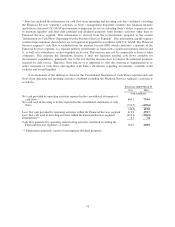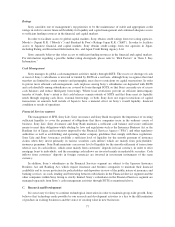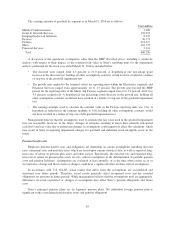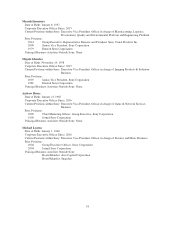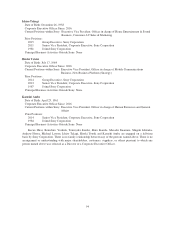Sony 2015 Annual Report Download - page 84
Download and view the complete annual report
Please find page 84 of the 2015 Sony annual report below. You can navigate through the pages in the report by either clicking on the pages listed below, or by using the keyword search tool below to find specific information within the annual report.comparison of the estimated fair value of a reporting unit to its carrying amount to identify potential impairment.
Reporting units are Sony’s operating segments or one level below the operating segments. If the fair value of a
reporting unit exceeds its carrying amount, goodwill of the reporting unit is considered not impaired and the
second step of the impairment test is not performed. If the carrying amount of a reporting unit exceeds its fair
value, the second step of the goodwill impairment test is performed to measure the amount of impairment loss, if
any. The second step of the goodwill impairment test compares the implied fair value of the reporting unit’s
goodwill with the carrying amount of that goodwill. If the carrying amount of the reporting unit’s goodwill
exceeds the implied fair value of that goodwill, an impairment loss is recognized in an amount equal to that
excess. The implied fair value of goodwill is determined in the same manner as the amount of goodwill
recognized in a business combination. That is, the fair value of the reporting unit is allocated to all of the assets
and liabilities of that unit (including any unrecognized intangible assets) as if the reporting unit had been
acquired in a business combination and the fair value of the reporting unit was the purchase price paid to acquire
the reporting unit. Indefinite lived intangible assets are tested for impairment by comparing the fair value of the
intangible asset with its carrying value and if the carrying value of the intangible asset exceeds its fair value, an
impairment loss is recognized in an amount equal to that excess.
Determining the fair value of a reporting unit under the first step of the goodwill impairment test and
determining the fair value of individual assets and liabilities of a reporting unit (including unrecognized
intangible assets) under the second step of the goodwill impairment test is judgmental in nature and often
involves the use of significant estimates and assumptions. Similarly, estimates and assumptions are used in
determining the fair value of indefinite lived intangible assets. These estimates and assumptions could
significantly impact whether or not an impairment charge is recognized as well as the magnitude of any such
charge.
In its impairment review, Sony performs internal valuation analyses or utilizes third-party valuations when
management believes it to be appropriate, and considers other market information that is publicly available. The
fair value of a reporting unit or indefinite lived intangible asset is generally determined using a discounted cash
flow analysis. This approach uses significant estimates and assumptions including projected future cash flows,
the timing of such cash flows, discount rates reflecting the risk inherent in future cash flows, perpetual growth
rates, earnings multiples, determination of appropriate comparable entities and the determination of whether a
premium or discount should be applied to comparables. Consideration is also given to Sony’s market
capitalization in relation to the sum of the calculated fair values of the reporting units, including reporting units
with no goodwill, and taking into account corporate level assets and liabilities not assigned to individual
reporting units as well as a reasonable control premium.
The assumptions used for projected future cash flows and the timing of such cash flows are based on the
forecast and mid-range plan (“MRP”) of each reporting unit and take into account such factors as historical
experience, market and industry information, and current and forecasted economic conditions. Perpetual growth
rates are utilized to determine a terminal cash flow value and are generally set after the three-year forecasted
period for the MRP. Certain reporting units, such as those in the Pictures segment, utilize longer forecast periods
and base the terminal value on an exit price using an earnings multiple with a control premium applied to the
final year of the projected cash flows. Discount rates are derived from the weighted average cost of capital of
market participants in similar businesses.
For all reporting units with goodwill, fair value exceeded the carrying amount, and therefore no impairment
existed and the second step of the impairment test was not required. Every reporting unit’s fair value exceeded its
carrying value by at least 10.0 percent. Also, for indefinite lived intangible assets, fair value exceeded the
carrying amount, and therefore no impairment existed.
84


